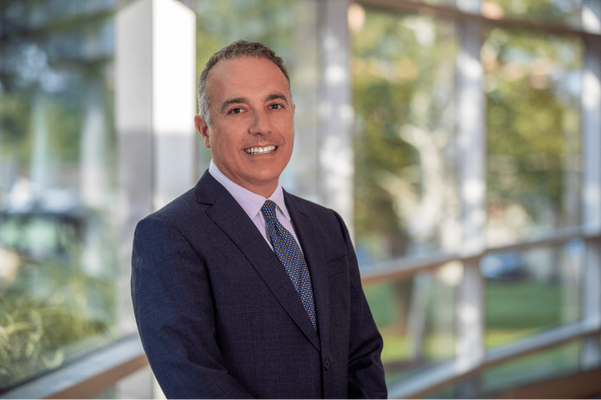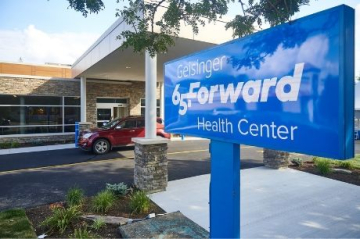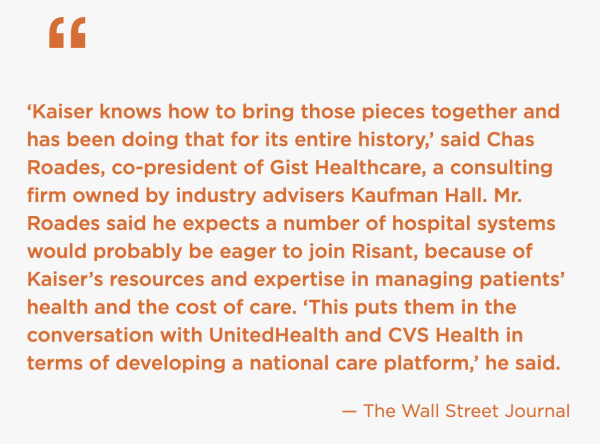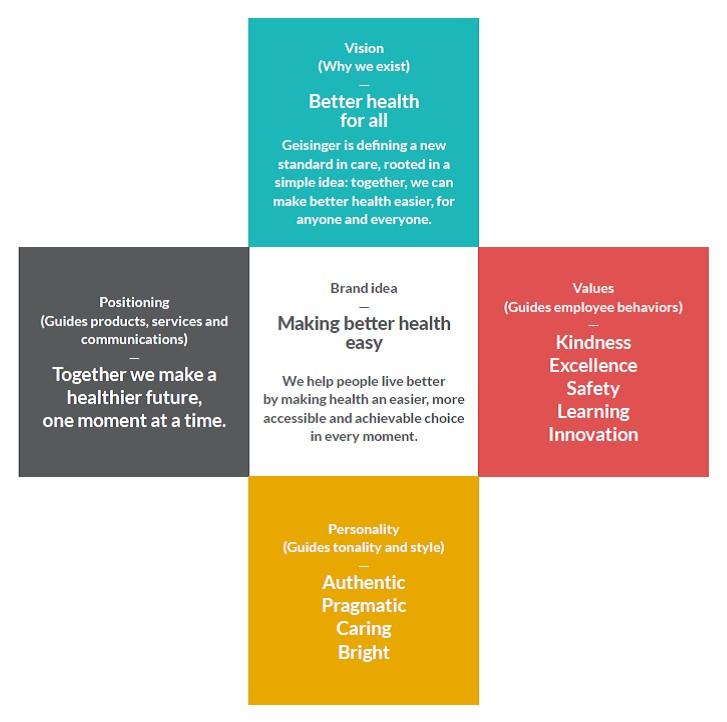
James Gardner, Director of Healthcare Strategy at OHO Interactive, recently spoke with Don Stanziano, Chief Marketing and Communications Officer at Geisinger, a prominent integrated provider and payor system in Pennsylvania. Their far-ranging conversation explored Don’s roots in journalism, how to earn influence (and get results) as a healthcare marketer, and recent innovations at Geisinger. This is the second in a series of articles celebrating the journeys, insights, and successes of select healthcare marketing leaders.
If there’s one theme that has shaped Don Stanziano’s remarkable career in healthcare marketing, it’s curiosity—a force that has propelled him since childhood.
“I always wanted to be a journalist, and I even started the first newspaper at my grade school,” he recalls. “As I built the skills of storytelling and interviewing, I found out just how interesting people and their life experiences are. Coupled with that, I had a desire to do good in the world and be a change-maker.”
Don, like fellow change catalyst Douwe Bergsma at Georgia’s Piedmont, took an unconventional path to healthcare marketing leadership. But his innate ability to question the status quo has taken him to the highest levels at Geisinger, one of America’s most innovative and respected healthcare systems.

After spending the first 10 years of his career as a journalist, Don transitioned to public relations when a local hospital executive encouraged him to consider options in the field. He landed in media and external relations at San Diego–based Sharp HealthCare and later at nearby Scripps Health.
When Scripps promoted him to VP of Marketing, he quickly threw himself into the new areas of his portfolio: marketing and digital. Ever the journalist, he asked his newly inherited team: “How do we know how much to spend on our campaigns? How do we decide who to target? What data do we have to inform these decisions?”
The year was 2010, and Scripps, like many healthcare organizations at the time, lacked a mature marketing technology infrastructure. Undeterred, Don schooled himself on modern marketing technologies like those for managing content and customer relationships. He read voraciously, networked at healthcare conferences, and often engaged with fellow CMOs to understand the rapidly evolving landscape. Don’s instincts for asking questions and always learning have served him well ever since.
In 2017, a recruiter approached Don about working with Geisinger, a Pennsylvania–based system with 10 hospital campuses, two research centers, a college of health sciences, and a nearly 600,000-member health plan.

With 24,000 employees and $8 billion in annual revenue, Geisinger serves more than 1.3 million patients and members annually across central Pennsylvania and beyond.
“There is impressive research happening here, and it is focused on improving access and delivery of care,” Don explains. “We’re able to bring sophisticated care to a market that is largely rural and would otherwise have to travel for the level of care we provide. We're rooted in the communities we serve, and we reflect those values—dedicated, authentic, pragmatic, caring. We're a brand with a great story to tell.”

“I was extremely impressed by Geisinger’s reputation,” he goes on. “They clearly valued marketing and communications, and they had an appetite for change, which made my decision easy.”
With new leadership and commitment, Don and his team have reimagined the Geisinger brand and its value proposition to the communities it serves. They’ve also integrated Geisinger’s marketing and communication functions, and—perhaps most significantly—introduced data-driven, digital-first marketing.
“I’m a total geek when it comes to this stuff,” Don laughingly acknowledges. “My team members are always surprised when I start going deep on a campaign we’re running. I'll ask, ‘What if we segmented the audience this way? What would that cost per lead look like?”
His passion for results-oriented marketing is contagious. Don continues, “It’s just fascinating to me, the cause and effect that marketing can demonstrate when it’s done well, and with the tools we have available to us now, we can actually be accountable for driving business results.”
Staying in the trenches might be unusual for a CMO, but it allows Don to shore up the perceived value of the marketing and communications team. “In healthcare, the marketing function is often seen as expendable when budgets are tight,” he notes. “We need data to show that we’re aligned to the business objectives—that we’re an investment, not an overhead department. We’re building a marketing function that does that, and a communications function that creates an environment where marketing can flourish.”
Speaking the language of business and proving his team’s impact have also earned Don the attention and respect of his peers. I sometimes hear how challenging it can be for marketing leaders to earn a seat at the decision-making table, so I asked Don what it takes to get there.
“I think what’s allowed me to have influence at both Geisinger and Scripps is my understanding of the business,” he explains. “It goes back to my journalism training. I ask a lot of questions. I want to understand. Just because our team writes press releases and manages social media channels doesn’t mean I don’t understand the finances of the company or the important relationships we have with payors or other providers or vendors.”
He continues, “My advice to anybody who wants to sit in this chair in healthcare is to get to know the business. You can do some of that through self-education. But it’s also having conversations, pushing your way into the right meetings and making time to listen and ask questions.”
“For instance, talk to the CFO. How do we make money? Where do we lose money? What are our biggest revenue drivers? How does the dollar flow through the company? Or ask human resource leaders: What are our biggest challenges in staffing? What positions are harder to fill? Where are we most competitive? From there, we can see clear ways to work together on our shared goals, whether it’s growing revenue or building culture.”
Of course, aligning marketing with business priorities doesn’t happen automatically—it takes leaders like Don, who champion an integrated, cross-functional approach that touches every corner of the organization. It’s no surprise that Don’s team plays a direct role in addressing healthcare talent shortages via a strong employer brand and internal comms team.
“We all ‘own’ culture, and brand and culture are inextricably linked,” Don points out. “It makes total sense for us to partner with HR because we’re a service business. Every employee touchpoint with our customers is an opportunity to reinforce the brand.”
For all the talk about holistic marketing, Don is someone who walks the walk, guided by strong convictions about his work. “All marketing is storytelling, whether it's internal or external, earned, paid or owned, ” he says. “Our job is to find the through line of our brand message, mission, purpose, and value proposition and carry it through to our stakeholders.”
These strong partnerships have brought Don behind the scenes at a healthcare organization that extends beyond traditional boundaries. Geisinger, with its “payvider” model, is uniquely positioned as a pioneer in value-based care.

“Because of our care and coverage model, our financial incentives and motivations may be a little different than other integrated delivery systems that don’t have a strong insurance business unit. We’re motivated not just by our values to take care of people inside the walls of the hospital, but also to ensure that they’re healthy all the time,” Don says.

Supporting the shift to value-based care, Geisinger has been building programs to improve preventive care, reduce unnecessary waste in the system, and improve both efficiency and outcomes. “We’ve put a lot of investment and focus into top-of-funnel services,” Don explains. These offerings include Geisinger’s Fresh Food Farmacy, which helps participants manage their medical conditions through food-related behavior and lifestyle changes, Geisinger at Home, which brings personalized at-home healthcare to eligible members, and Geisinger 65 Forward, which offers primary care and wellness services for seniors on Geisinger's Medicare Advantage plan.

“When you talk about a program like Geisinger at Home or 65 Forward, it’s not only the right thing to do for the patients and to meet the needs of the communities we serve, it’s also the right thing to do for the business. We’re decreasing utilization by improving the health of the patient, which reduces costs, not just for us, but also for everyone who pays into the healthcare system.”
In April 2023, California-based Kaiser Permanente—a long-time leader in value-based care—announced its intention to acquire Geisinger and form a new organization, Risant Health. Pending state and federal regulatory approval, Risant is expected to acquire additional health systems and promises an exciting new era of innovation in the financing and delivery of care.
“Through Risant Health, we will make our value-based care expertise, technology and services available to community-based health systems, like Geisinger, to strengthen their ability to provide value-based care models with a focus on high-quality and equitable health outcomes,” said Greg. A. Adams, chair and CEO, Kaiser Permanente.

In the competitive realm of healthcare marketing, organizations often strive to differentiate themselves with clinically focused messaging. While Geisinger promotes its clinical programs, it’s also embraced another tack.
“Most patients use service as their frame of reference,” Don points out. “Were the hospital staff nice to me on the phone? Were they helpful at the front desk? Could I get an appointment when I wanted one? Was my bill accurate? Was the facility clean and easy to get around? Those are the things they evaluate.”
With that in mind, Don believes that healthcare organizations should seek tactical ways to improve the patient experience—like clear signage that makes it easier to navigate the hospital.
“We've made wayfinding part of the branding, because our brand promises making better health easier,” Don says. “We've also been working with our facilities team on the design of our entryways and lobbies, to create a branded experience, like you have at Starbucks and Target. You walk into those places and you know exactly where you are. We want that same experience at Geisinger.”

Don’s sentiment about bringing human touchpoints into modern-day branding echoes Geisinger’s origin story. In 1915, founder Abigail Geisinger set out, at age 85, to meet the need for advanced healthcare in her rural central Pennsylvania community. “Make my hospital right; make it the best,” she said at the time.
Today, Geisinger aspires to “make better health easier” for patients, members, employees and its communities. With a service-centric approach to marketing and communications, Don believes Geisinger and other healthcare organizations can create a lasting impact.
Don, like many of us, is champing at the bit to incorporate truly useful technology in his work. At the same time, he cautions against getting too distracted by, as he puts it, “shiny objects” without making sure they have a tangible and potentially profound impact on our customers’ experience — for example, artificial intelligence.
“I think there's a lot of promise to use AI to help personalize the digital customer journey,” Don notes. “So, how do we take advantage of these tools to apply technology to our marketing tech stack so that we can give people that truly personalized guided experience? I think healthcare is a bit of a laggard in technology and a laggard in marketing. You put those two things together, and we’re really playing catch up. One of the reasons for that is that we're incredibly complicated, eclectic, highly regulated, and we deal with an immense amount of highly personalized, personal, sensitive information that is hard to digitize without a lot of guard rails. Even with all those hurdles, I still think there's an opportunity to personalize the digital journey through AI."
Looking even further ahead, Don anticipates ongoing disruption in healthcare, with mergers and acquisitions among health systems and payors. “I think the industry will look very different in three to five years—for one thing, we’ll have fewer, bigger health systems,” he says.
Indeed, if the industry follows in Geisinger’s quickly growing footsteps, we’re set to see major change. I’ll be observing Geisinger closely—and so, I know, will many others.
(Thanks to Don and the Geisinger marketing team for their collaboration. I'll be profiling more healthcare marketing leaders in the coming weeks and months. If you'd like to be considered for the series, please contact me.)
 James Gardner
James Gardner
Director, Healthcare Strategy
The original version of this page was published at: https://www.oho.com/blog/listening-learning-leading-conversation-don-stanziano-chief-marketing-and-communications-officer
OHO Interactive helps ambitious, forward-looking marketers maximize their investments in digital to elevate their organization’s prestige and recruit the customers they need.
What are the essential 2023 marketing, communications, and web conferences for hospital and health system marketers?Who doesn't enjoy attending healthcare marketing conferences? ...read more
Blue Cross Blue Shield affiliates are a powerful force in health insurance, collectively serving over 115 million Americans. What can we learn from a look at some of their more noteworthy ...read more
James Gardner, Director of Healthcare Strategy at OHO Interactive, recently spoke with Douwe Bergsma, Chief Marketing Officer at Piedmont, a highly respected health system ...read more
Healthcare organizations and health insurers can implement an inbound content marketing strategy to improve brand recognition, attract new patients, and stay engaged with their current ...read more